OLIVEIRA, Rita de Cássia Esteves de [1], FECURY, Amanda Alves [2], DIAS, Cláudio Alberto Gellis de Mattos [3], OLIVEIRA, Euzébio de [4]
OLIVEIRA, Rita de Cássia Esteves de. Et. al. Epidemiological profile of HPV sexually active women, ranging in age from 10 to 80 Years. Magazine Multidisciplinary Scientific Knowledge Center. Year 01, Ed. 07, Vol. 04, pp. 21-34. July of 2016 – ISSN:0959-2448
SUMMARY
The human papillomavirus (HPV) infects the basal cells of the epitelio scaly and may cause benign or malignant. HPV 16 and 18 are agents of cervical carcinoma etiologicos while the 06 and 11 form the Condyloma acuminata. The objective of this research was to characterize the epidemiological profile of the sexually active female population in the age group of 10 to 80 years in the metropolitan region of Belém. The survey was conducted by means of Epidemiological investigation of reported data in SINAN. The bairro da Marambaia had the largest number of notification (10.32%), followed by the Guamá (9.39%) and the Mainland (6.91%); the districts with lower notification number were the neighborhood Cutijuba district (0.21%) and of Aurá (0.10%). The predominant age group of 20-34 years with (44.73%), followed by 15-19 years (34.29%). The majority of women affected by HPV average level of incomplete education (43.59%). It was possible to see how great the need to discuss, implement public policies with programmes of prevention and control to combat this virus through emblematic actions that can prevent such a population.
KEY WORDS: HPV; Epidemiological, female population. Bethlehem.
INTRODUCTION
The cervical cancer of uterus is the second type of cancer most frequently among the female population with an estimated 500,000 new cases in the world according to the International Agency for research on cancer (IARC), however, when the diagnosis is discovered early is also the cancer with greater potential to cure (BRAZIL/INCA, 2009).
In Brazil the estimate of cervical cancer of uterus for the 2010/2011 year was approximately 18,430 new cases remaining have 18 cases for every 100,000 women (18/100,000). The infection that can relate with this type of cancer is directly related with the Human Papilomavirus (HPV). Is a sexually transmitted disease (STD) viral etiology and as main risk factor the multiplicity of partners where most often the infection is transient, but may also be carcinogenic co-factors such as smoking, characterized by oral contraceptives (DICK, 2002).
Were held in the Brazil exam 12,000,000 benefiting 80% of sexually active female population, the northern region of the country with the highest incidence of cancer of the cervix (23/100,000), with the second highest incidence to the Midwest (20/100,000) and the South (21/100,000) and Southeast (16/100,000) (BRAZIL/INCA, 2009).
Based on this information, as well as in all other existing data related to HPV in women, is that if you have the question: to what extent the difficulty for information is the villain in the fight against the reduction of incidence of HPV in women sexually active?
Given this, the realization of the research assumed greater understanding emerge about the epidemiology of HPV in women sexually active during the period 2008 to 2014, since new insights can be triggered from the construction of scientific knowledge, pointing out the features and the epidemiological profile of the population affected by HPV, and thus serving as scientific material of an educational character, informative , reflective and didactic.
Thus the present research aimed to characterize the epidemiological profile of the sexually active female population in the age group of 10 to 80 years in the metropolitan region of Belém. Analyzing the incident cases by districts and age group and describing the socio-economic profile of the population infected by HPV.
METHODOLOGY
Descriptive methods were used in this study, with a quantitative and qualitative approach; being adapted to the local community as the Brazilian Epidemiologic Guide (1998), where reports that research has as objective: Conduct the confirmatory diagnosis, determining the epidemiological characteristics of the disease, to guidance on control measures.
For this study there was the selection of the sexually active female population in the age group of 10 to 80 years in the metropolitan region of Belém, which had sample positive for HPV (06, 11, 30, 42, 43, 45, 51, 54, 55.70), which are commonly known as Condyloma Acuminatum Verruca, genital.
Was held at the care centre in infectious diseases Acquired (Days) located at Travessa Diogo Moia N° 1119 – Brazil, Belem, PA, postal code: 66055170.
This research was operationalized through Epidemiological investigation in the neighborhoods Served by the existing data tracking information system of reportable diseases (SINAN).
The analysis of the data was accomplished through collations in tables by neighborhood in the city of Belém-PA and age, the presentation of the data was performed through tables and charts followed by the discussion of the data present in the same.
RESULTS AND DISCUSSION
Table 1, shows that the municipality of Bethlehem had an incidence of 968 cases of HPV in the 2008 period notified 2014, where they showed the Marambaia with 100 confirmed cases followed by the districts of 91casos and Northern Mainland with 67 confirmed cases. Data from the Ministry of health of the year 2009 report that Brazil is one of the world leaders in incidence of HPVs, taking to the region North of the country the largest notification (INCA, 2009). These data show the need to do an educational policy in this population that need to have access to conditions and determinants offered peo SUS, as prevention, treatment and good service.
Panisset and Fonseca (2009) state that Brazil data are scarce and does not translate the true magnitude of the infection, the global incidence of confirmed virus. This scarce access reported by authors is confirmed in table 01 in upper-middle-class Neighborhoods like: old city and Batista Campos.
The high rate of teenagers and young adults across the country contributes to the fact that the majority of the brazilian population that this focused basically on the outskirts of large cities, report low socio-economic level, which is in the process of transmission of HPV. Being likely that young people also get minimum information with respect to the risk of disease, although the population most affected by risk.
| Table 1. Number of cases of HPV (Condyloma acuminata) in female patients residing in Bethlehem-PA, in the period from 2008 to 2014. | |||
| Female (number of cases) | |||
| Neighborhoods | Absolute frequency (fa) | Relative frequency (fr) | |
| Marambaia | 100 | 10.32% | |
| Guamá | 91 | 9.39% | |
| Terra Firma | 67 | 6.91% | |
| Beautiful Waters | 66 | 6.81% | |
| Tapanã | 53 | 5.47% | |
| Sacramenta | 45 | 4.64% | |
| Marco | 44 | 4.54% | |
| Quarry | 40 | 4.13% | |
| Condor | 38 | 3.92% | |
| Yudjá | 37 | 3.82% | |
| Benguí | 34 | 3.51% | |
| Telegraph | 34 | 3.51% | |
| Cabanagem | 32 | 3.30% | |
| Cremation | 31 | 3.20% | |
| Icoaraci | 27 | 2.79% | |
| Straws | 23 | 2.37% | |
| Fatima | 23 | 2.37% | |
| Tenoné | 21 | 2.17% | |
| Pratinha | 21 | 2.17% | |
| Val de Cans | 17 | 1.75% | |
| Green Park | 14 | 1.44% | |
| Coconut tree | 14 | 1.44% | |
| Brazil | 13 | 1.34% | |
| Curió Utinga | 12 | 1.24% | |
| Outeiro | 9 | 0.93% | |
| Corral | 9 | 0.93% | |
| Castanheira | 8 | 0.83% | |
| A | 8 | 0.83% | |
| São Brás | 7 | 0.72% | |
| Mosqueiro | 7 | 0.72% | |
| Guanabara | 5 | 0.52% | |
| Old Town | 4 | 0.41% | |
| Batista Campos | 4 | 0.41% | |
| Guajará Park | 4 | 0.41% | |
| Souza | 3 | 0.31% | |
| Cotijuba | 2 | 0.21% | |
| Aurá | 1 | 0.10% | |
| Total | 968 | 100.00% | |
Source: SESMA-CMDST/AIDS, Bethlehem-SINAN NET.
It should be noted that the data were analyzed by age group, in order to identify the number of cases. As can be seen in Figure 1.
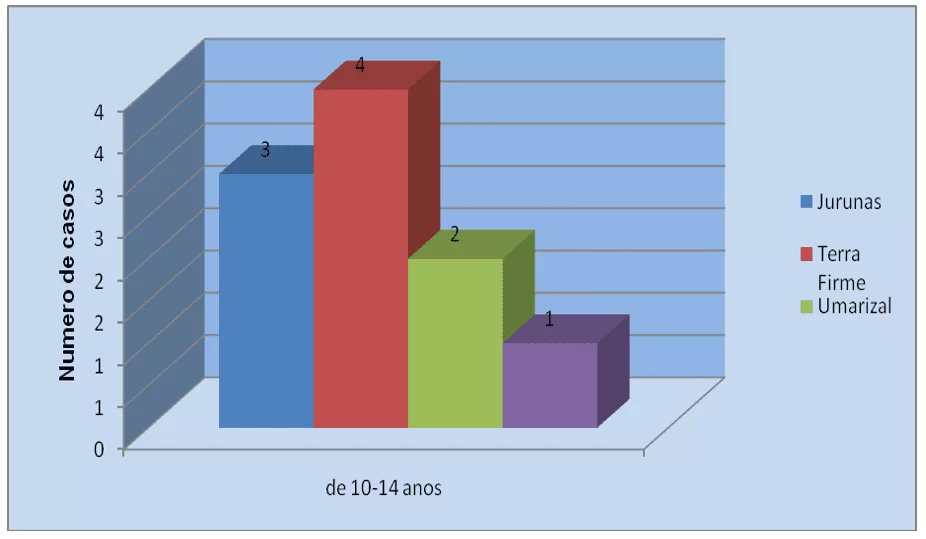
According to the data obtained in this research, we analyzed the data by age group where noted in Figure 1, 38 reported cases ranging in age from 10 to 14 years in the city of Bethlehem, where the land appears with 04 cases with greater notification.
Dick et al. (2002), report that the HPV infection is transmitidada and spread from person to person by direct contact as the multiplicity of partners mainly in the beginning of sexual intercourse which is a major risk factor for contracting HPV. According to Rehme et al. (1998) the diceminação of HPV during childhood and adolescence does not cause immediate severe morbidity, but early contamination slows the involvement of anogenital cancers.
In adolescence the sex begins earlier each time and with greater promiscuity due the higher number of partners, which contributes to increase the occurrence of HPV. However, it is important to stress that the decentralization of SUS and inadequate training of health professionals hinder early diagnosis, contributing to the spread of the disease especially in the North and northeast regions of the country due to the huge territorial extension.
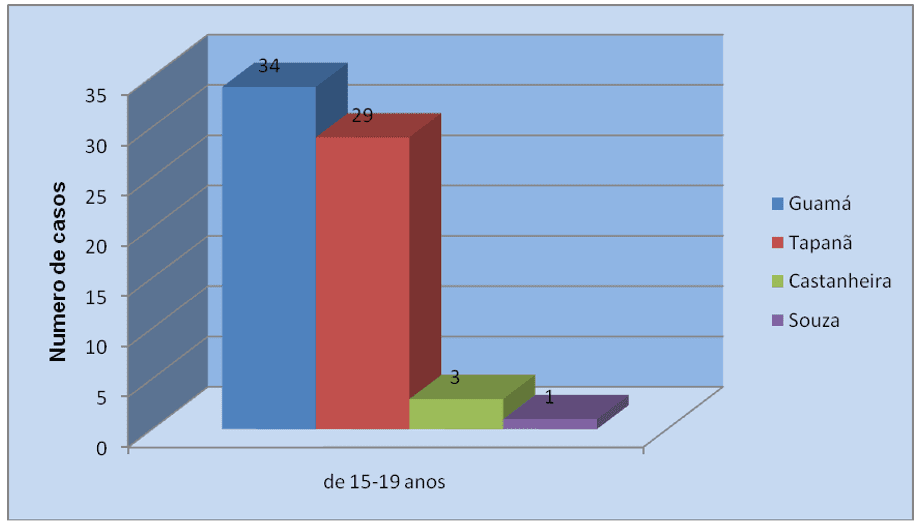
Sampling, presented in Figure 2, is represented by 332 cases in the age group of 15 to 19 years where the neighborhood more notified is the Guamá with 34 cases, followed by the Mainland with 33 cases and Tapanâ with 29 reported cases.
According to Moscick (2007), young people with active sex life have a high prevalence and infection rate for HPV, where most infections are asymptomatic. However, Brazil (2002), points out that the citopatológico test doesn’t diagnose HPV infection and even detects its type, but it has great importance for help in the early diagnosis of cervical cancer in these adolescents to help defer likely virus cells.
It was in these results, as well as in literature, the great importance of an educational policy with greater collective effort to increase the supply of the Pap test advocated by the Ministry of health. To detect any abnormality in this population since adolescents in this age group rarely seek a gynecologist and are not prepared yet to diagnose signs and symptoms of this disease.
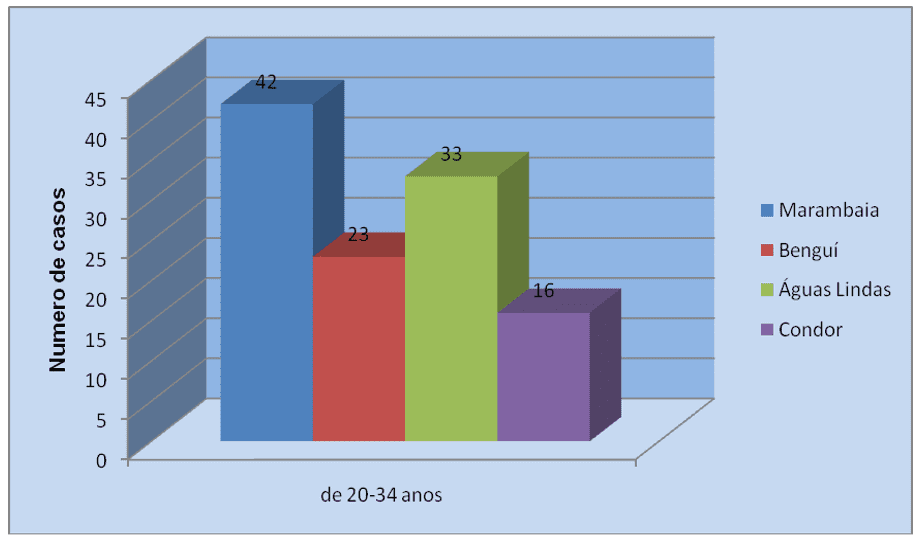
Analyzing the data (Figure. 03) by age group of 20 to 34 years old, there was a high prevalence in this age group with 433 cases reported getting the neighborhoods of Marambaia with 42 cases followed by Beautiful Waters with 33 cases reported.
According to Brazil (2006), the HPV infection is predominant in the age group of 25 years due to the vulnerability that may cause condilomatosas lesions co-factors, intraepithelial neoplastic, with the possibility of developing cancer of the vulva, vagina, anal region. Second Myrtle (2001) the habit of smoking is directly related to the high incidence of HPV infection and prevalence of neoplasms pré-invasivas of uterine neck development.
By limiting the number of sexual partners, reduce the number of women infected by HPV, since the condom does not cover the whole area of genital HPV region if acomede by intimate contact without need of sexual act, while remaining clear once again that this population needs an education in public health.
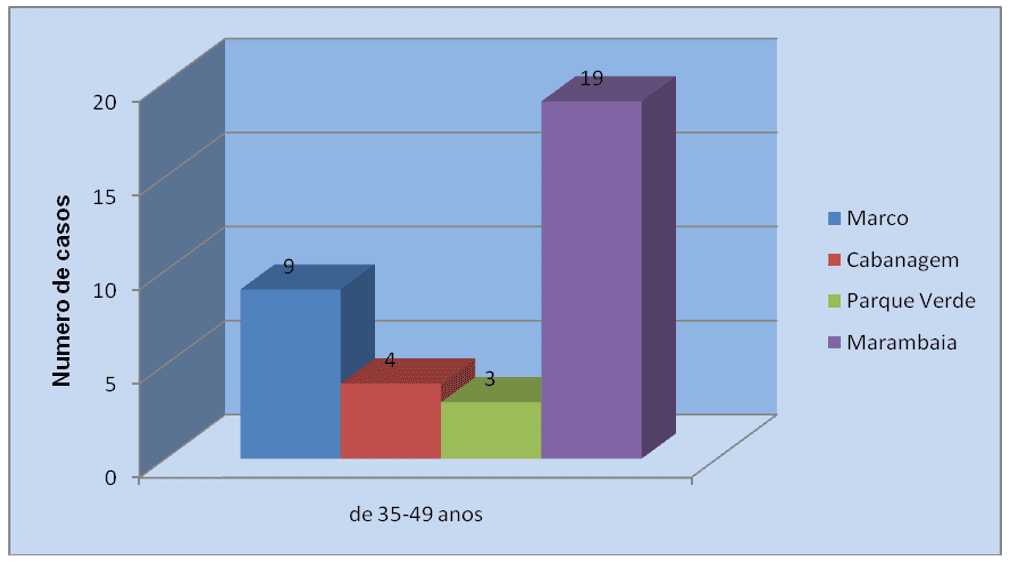
When analyzed the age range of 35 to 49 (Figure 4), 113 reported cases, where the Neighborhood more notified is the Marambaia with 19 cases, followed by Monrovia with 10 cases and the landmark district with 09 reported cases and one can see a beginning of a decline.
Nakagawa (2010) States that the prevalence of high-risk HPV infection is greater in women ranging in age from 35 years before the 65 years where the biggest effects are in poor countries such as Africa, South America, including Brazil. Nakagawa also describes that countries that have managed to reduce the cases of HPV disease was with the implementation of policies and programs to combat HPV trace.
Research shows that 271 women infected with HPV have full high school residing in the neighborhood of women Tapanã 17, followed by 15 in Mainland and 12 in the Telegraph. Most women acuminate HPV has the purchasing low social economic profile, focus on the outskirts and probably desconhecé the commitment of the disease. The lack of preparation of health professionals, especially healthy family influences directly in this patient population that needs information and correct treatment to recovery.
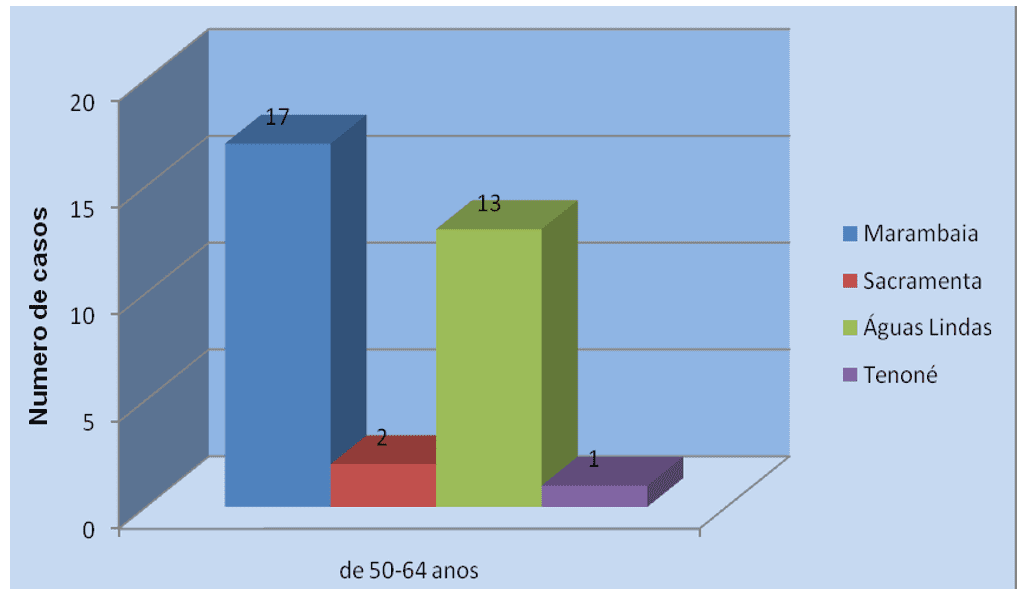
In the age group 50 to 64 years, as shown in (figure. 05), 41 remaining cases the Marambaia with 17 confirmed cases followed by Beautiful Waters with 13 cases.
According to INCA (2009) the cervical cancer has a higher incidence in women aged 40 to 60 years, infected by HPV, graduating in slow form raisins unnoticed by preclinical phases detectable to suffer change of high degree, tormando in cancer.
The program Alive woman who makes the control of cervical cancer of uterus aims to perform actions of prevention to every woman who has had or has an active sex life. But need a large national mobilization suffers to ensure proper treatment to women who possess precursors in order to improve the quality of care to the woman, in the different stages of the program.
| Table 2. Distribution of cases of HPV (Condyloma acuminata) in patients residing in Bethlehem, in Neighbouring Municipality and district neighborhoods of Bethlehem female, in the period from 2007 to 2010. | |||
| Location | Female (number of cases) | ||
| Absolute frequency (fa) | Relative frequency (fr) | ||
| Adjacent neighborhoods (Beautiful Waters and Aurá) | 89 | 9.18% | |
| Districts of Bethlehem (Icoaraci, Hill and Mosqueiro Cotijuba) | 38 | 4.02% | |
| Bethlehem
|
841 | 86.79% | |
| Total | 968 | 100.00% | |
Source: SESMA-CMDST/AIDS, Bethlehem-SINAN NET.
In table 2, the distribution of HPV cases, in Neighbouring Districts with district and Santa Fe.
By analyzing the districts bordering with Ananindeua is observed and district 128 cases, where the neighborhoods are notified: coconut tree features 14, Castanheira, Beautiful Waters 08 66, and in both the prevalent age group for HPV is 20 to 34 years with 46 cases reported already Aurá with 01 notification at the age of 80 years.
The neighbouring district neighborhoods served by cases are: Icoaraci presents 20 cases, cases, Outeiro 07 Mosqueiro 10 cases, Cotijuba 02 cases. The predominant age group in both cases is 20 to 34 years with 19 reported cases.
According to Santos (2008), the prevalence of HPV infection is directly related to the number of sexual partners and its peak is observed among teens adult women between the ages of 15 to 30 years. Rossenblatt (2008). Reports that after this age group is a linear decrécimo due the risk group for HPV to be women in the early onset of sexual activity, unmarried and multiple partners, nulipara with more than one partner.
Valley report that the Group of young women may have an HPV infection already trasitória the Group of mature women with percistentes for HPV oncogenic infections requires constant care and demand for trace of cancer.
FINAL CONSIDERATIONS
At the end of a work of this nature you can tell how great the need to discuss, formulate and implement public policies with programmes of prevention, control and fight this disease. The results obtained in the survey showed that:
- The lack of knowledge and information to contribute and to spread of HPV, the sexually active population basically only the AIDS virus, widespread in the campaigns of the Ministry of health guidance;
- The age group most affected by HPV is 20 to 34 years with 44.68% reported cases in adolescents adults;
- There was a decline when the age group reaches the age of 50 to 64 years with 4.23% of reported cases;
- The neighborhood more notified the Marambaia with 10.32% of reported cases;
- Socioeconomic profile shows that the average level incomplete notified is 422 cases with 43.55 percent, where the neighborhood of Guamá has an incidence of 45 cases or 9.64%, followed by the Mainland with 42 cases or 4.33% of reported incidences.
Given this, one can see that the majority of women infected by HPV social economic profile of low income, and focus on the outskirts of the city unaware of the causes and consequences of STDS/HPV. These results lead to believe that the population investigated is in the statistics with a low education (semi-alfabetizada or illiterate), influencing in your life with regard to health and above all self-respect.
Notice also that the districts considered noble, do not appear in notificaçõesdo SINAN, however does not mean that no cases of HPV occur in this population. What is believed to occur is that those people have a greater buying power, which provides the seek medical attention in private networks and that unfortunately these hospitals and clinics do not make notification of positive cases of HPV to SINAN, for not being a notifiable disease.
Therefore, it is concluded that there is a need for greater commitment on the part of public health in Brazil in charge of private networks of health harms nusitados notifications for such a situation, not to mask the records and the conclusions of SINAN.
REFERENCES
Alencar, Taina Raiol. Analysis of genetic variability, phylogeny and gene expression of high-risk HPV in the Federal District. 2009. 136 f., il. Thesis (PhD in Molecular Biology) – University of Brasília, Brasília, 2009. Available: http://hdl.handle.net/10482/4068. Access in: 15 may 2012.
Hebert Roberto Clivati Brandt, et al. Treatment of human papilloma virus in childhood with the imiquimode 5% cream. An. Bras. Dermatol. [online]. 2010, vol. 85, no. 4, pp. 549-553. ISSN 0365-0596. DOI: 10.1590/S0365-05962010000400020. Available at: http://www.scielo.br/scielo. Access in: 15 may 2012.
BRAZIL, Ministry of health. Notebooks of the basic attention paragraph. 13. Control of Cancers of the cervix and breast. Brasilia. 2000.
__________. Ministry of health. Technical Manual. Health professionals. Prevention of the cervix. Brasilia. 2002. Available at http://bvsms.saude.gov.br/bvs/publicacoes/inca/manual
__________. Ministry of health. The National Cancer Institute. 2010 estimate: incidence of cancer in Brazil/National Cancer Institute – Rio de Janeiro: INCA, 2009. Available in http://pt.scribd.com/doc/53165809/INCA-estimate-2010-Incidence-of-Cancer-in-Brazil
__________. Ministry of health. National Health Foundation. National Centre of epidemiology. Pocket Guide/prepared by Gerson Oliveira Penna et al. Infectious and parasitic diseases: clinical aspects of epidemiological surveillance and control. Brasilia, 1998. Available at http://bvsms.saude.gov.br/bvs/publicacoes/funasa
FOCACCIA, r. Treaty of infectious diseases. 3. Ed. São Paulo: Atheneu, 2006.
ZAHIRA/WASHINGTON. J. J et al. Microbiological Diagnosis. 6ed. Rio de Janeiro: Guanabara koogan, 2008
LEVINSON, Partho and Ernest Jawetz. Medical Microbiology and Immunology. 7ED. Porto Alegre: Artemed, 2005
MINISTRY OF HEALTH. Pap test collection and teaching of Breast Self-examination. 2ed. São Paulo, 2004.
Monteiro, Jacqueline Chirwa. Prevalence of infection by the human Papilomavirus (HPV) in cervical cancer investigated for women, in the city of Belém, Pará, 92f Master thesis in biology of infectious agents and Parasitological. Institute of biological sciences, Federal University of Pará. 2009. Available at: http://www.baip.ufpa.br/arquivos_baip/teses. Accessed on: 10 April 2012.
MOSCICKI AB, Palefsky J, Gonzales J, Schoolnik GK. Human papillomavirus infection in sexually active adolescent females: prevalence and risk factors. Pediatr Res 1990; 28:507-13. Translated by Google translate, 2007. Available at: http://www.scielo.br/scielo. Access in: 15 opening 2013.
Myrtle, Eddie Fernando Candido; Souza, Mary Azniv Hazarabedian; ADAD, Sheila Jorge and AHMAD JUNIOR, Edward. Human Papillomavirus Infection in adolescents: relationship with the Contraceptive Method, pregnancy, smoking and Cytological Findings. Rev. Bras. Ginecol. Obstet. [online]. 2001, vol. 23, no. 4, pp. 217-221. ISSN 0100-7203. DOI: 10.1590/S0100-72032001000400004. Available at: http://www.scielo.br/scielo. Access in: 15 may 2013.
Myrtle, Eddie Fernando Candido. Vaccine against HPV or cervical cancer? Rev. Bras. Ginecol. Obstet. [online]. 2007, vol. 29, no. 10, pp. 548-548. ISSN 0100-7203. DOI: 10.1590/S0100-72032007001000009. Available at: http://www.scielo.br/scielo. Access in: 15 may 2013.
NAKAGAWA, Janete Tamani Tomiyoshi; SCHIRMER, Janine and BARBIERI, Marcia. HPV virus and cervical cancer of uterus. Rev. bras. nurses. [online]. 2010, vol. 63, no. 2, pp. 307-311. ISSN 0034-7167. DOI: 10.1590/S0034-71672010000200021. Available at: http://www.scielo.br/scielo. Accessed: 14 may 2013.
Novaes, Hillegonda Maria Dutilh. The HPV vaccine and cervical cancer of uterus: challenges for its incorporation into health systems. Rev. bras. epidemiol. [online]. 2008, vol. 11, no. 3, pp. 524-525. ISSN 1415-790 x. DOI: 10.1590/S1415-790X2008000300022. Available at: http://www.scielo.br/scielo. Access in: 14 July 2014.
PANISSET, KSP; FONSECA, VLM. Cervical pathology in adolescent pregnant. 2009:6 (4): 33-40 Official Magazine of the Center for the study of Adolescent Health/UERJ volume 6 Health, paragraph 4. Outubro2009.80: http://www.adolescenciaesaude.com/detalhe_artigo.asp? id = 7. Acessodo on: 9 January. 2014.
PINTO, ÁLVARO P.; Tulio, HARSHAD and cross, OLIVIA RUSSIAN. Cofactors of HPV in cervical oncogênese. Rev. Assoc. Med. Bras. [Online]. 2002, vol. 48, no. 1, pp. 73-78. ISSN 0104-4230. DOI: 10.1590/S0104-42302002000100036. Available in http://www.scielo.br. Accessed on 20 November 2013.
RAMA, Cristina Elena et al. Prevalence of HPV in women tracked for cervical cancer. Rev. Public Health[online]. 2008, vol. 42, no. 1, pp. 123-130. ISSN 0034-8910. DOI: 10.1590/S0034-89102008000100016. Available at: http://www.scielosp.org/scielo. Access in: May 14. 2014.
RAMOS, Karina Serravale. Study of HPV and associate behavioral variable in women with high-grade intraepithelial lesion. 2009.66 f doctoral thesis in medicine. Federal University of São Paulo: available at http://www.teses.usp.br/teses/…/5/5134. Accessed on 05 July 2013.
REHME, Martha Francis Bala; CARVALHO, Newton Gina; IHLENFELD, Mauro Fernando Kürten and CHUERY, Ana Carolina Silva. Condyloma acuminata in children and adolescents. Rev. Bras. Ginecol. Obstet. [online]. 1998, vol. 20, no. 7, pp. 377-380. ISSN 0100-7203. DOI: 10.1590/S0100-72031998000700002. Available at accessed on 24 April http://www.scielo.br 2014.
ROSENBLATT, Charles et al. HPV in Clinical practice. New York: Athenaeum, 2005.
RUBIN, Emanuel et al. Pathology, Clinical Pathological Basis of medicine. 4 ed. Rio de Janeiro: Guanabara koogan, 2005.
SANTOS, Oladipo of the. Introduction to Human Virology. 2ed. Rio de Janeiro: Guanabara koogan, 2008.
SCHAECHTER, Moselio et al. Microbiology infectious disease Mechanism. 3ED. Rio de Janeiro: Guanabara koogan, 2002.
TRABULSI, Luiz Flavio Alterhum and Richard. Microbiology. 5ED. New York: Athenaeum, 2008.
TORTORA, Gerard et al. Microbiology. 8ed. Porto Alegre: Artemed, 2005.
[1] Biologist. Graduate student in microbiology from the College Ipiranga.
[2] Biomedical. Doctorate in Tropical Diseases. Professor and researcher of the Postgraduate program at Universidade Federal do Amapá, a researcher at the Center for Tropical Medicine at the University of Pará, AP.
[3] Biologist. Doctor in theory and research. Lecturer and researcher at the Federal Institute of Amapá-IFAP.
[4] Biologist. Doctor of medicine/Tropical Diseases. Lecturer and researcher at the Federal University of Pará – UFPA. Researcher of the Graduate program of the Center for Tropical Medicine UFPA.















